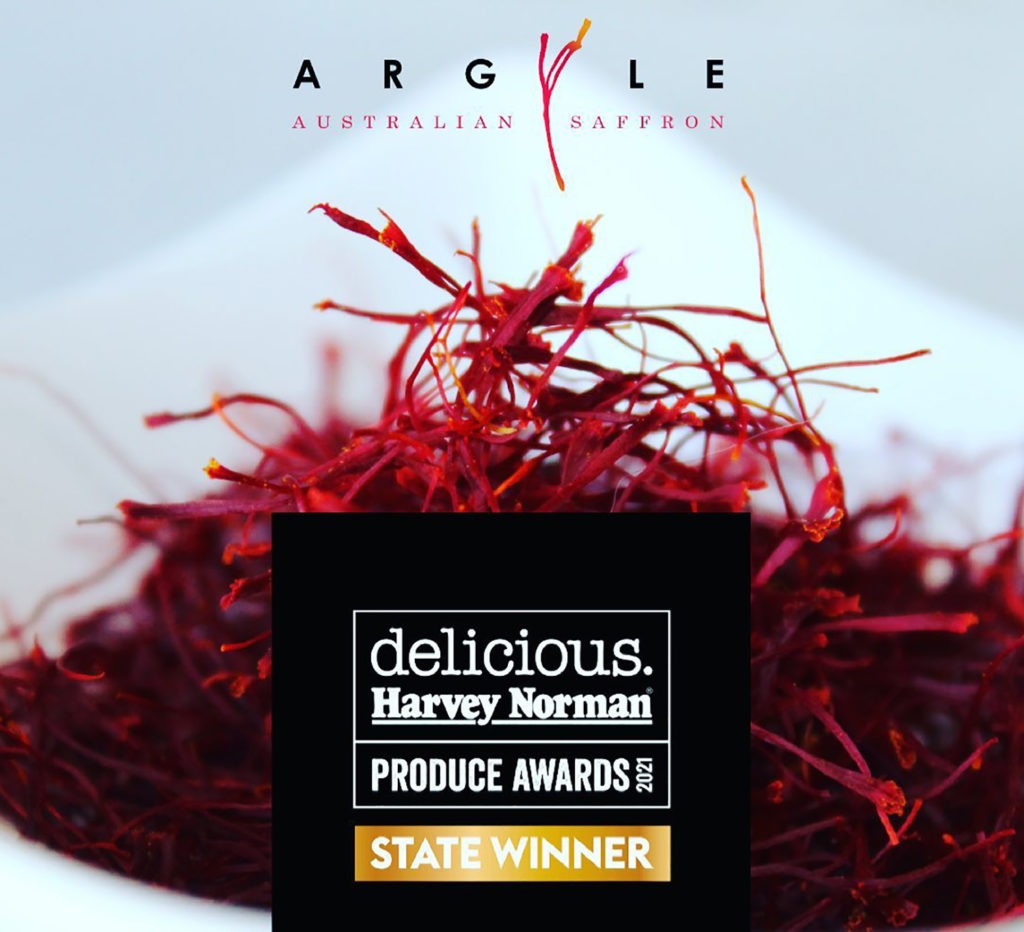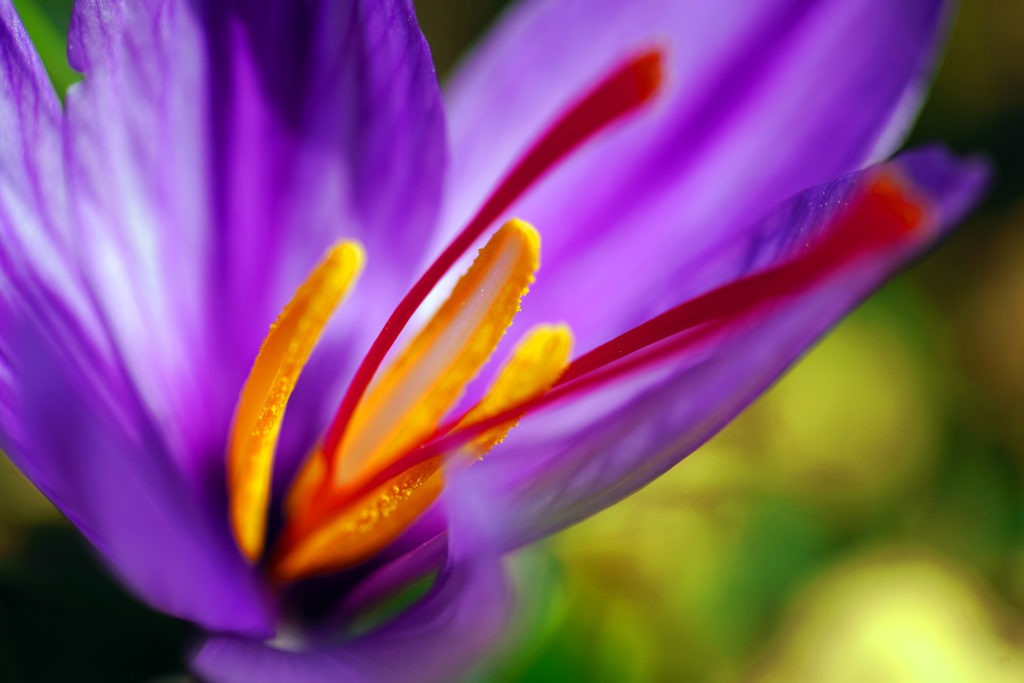Argyle Saffron: seeing red in Orange
Saffron is the world’s most expensive spice, literally worth its weight in gold. But this vibrant delicacy can do much more than simply add rich colour and flavour to your cooking. Emerging research is finding that saffron contains properties that can do everything from boosting your mood and smoothing your skin to improving eyesight and cognitive function.
The majority of the world’s saffron is grown in Iran, but here in Australia, there are a growing number of farmers who are developing a reputation for their high-quality saffron.
Brendon and Angela Argyle own and run Argyle Australian Saffron in the central-western NSW city of Orange. While the couple has only been growing saffron for the past four years – and previously had no farming experience – their product is so outstanding, they were recently named NSW state winners in the 2021 delicious. Harvey Norman Produce Awards.
“We relocated to Orange from Sydney about five years ago,” Angela says. “I don’t think I’d ever even cooked with saffron before that, and we had no experience with farming – my background is in financial planning. But we wanted to do something completely different. We naïvely went into it thinking, ‘Oh, this will be interesting. Let’s see if it grows here’.”

All hands on deck
It turns out that the climate in Orange is ideal for growing saffron, as it requires cold winters and autumns, and dry, hot summers. The saffron spice comes from the saffron crocus – a bulb that flowers for only a few short weeks in autumn. The beautiful purple flowers have three filaments, or stigmas, at their centre, and it is these vibrant orange-red threads that are so highly prized for their flavour, aroma and health-giving properties.
As Angela explains, the main reason for saffron’s high price is due to the fact that all planting and harvesting must be done by hand, and it takes a lot of work to produce a very small amount – around 250 saffron flowers produce one gram of saffron.
“I always say it’s relative,” she says. “You only need a tiny bit; maybe one strand. But it’s all very manual. When we first started, we hand-planted 20,000 bulbs. It took us two weeks.”
Saffron bulbs self-multiply in the ground, which means that every year, growers can expect to see their crops increase. While some may only produce another two or three bulbs, the Argyles have seen as many as 25 new bulbs from one plant. This year, they expect to produce around 600 grams of saffron. And all of this must be gently harvested by hand.
“We’re harvesting right now, so every morning, we get up at about six and hand-pick every flower in the paddock,” Angela explains. “At the moment, we’re picking about 5000 flowers a morning. Then we bring them back to the house and hand-strip the stigmas.”

Secret intelligence
While the climate and the Argyles’ hard work have led to successful harvests, what really makes Argyle Australian Saffron stand out from the rest is the drying method that’s used.
“We dry our saffron a bit differently to anyone else that I know of,” Angela says. “Most saffron farmers use normal food dehydrators to dry their saffron, and we did as well for our first year or two. But then there was another saffron farmer quite near to us who decided to finish up and we bought up all their stock. They were drying their saffron differently and had been rather secretive about how they did it – and their saffron was amazing. So, when I bought their stock, they agreed to sell me the secret, too.”
Unlike the previous saffron secret-keepers, the Argyles don’t keep their drying method under wraps. And it’s all quite simple: rather than using a food dehydrator, they use a conventional oven and good old-fashioned water.
“We dry very quickly with humidity by putting trays of water in the oven with the saffron,” Angela explains. “There have been lots of studies on drying saffron and what gets the best results. They show that if you dry with humidity, this coats the stigma and basically seals it.
“The feedback we’re getting since we’ve been doing this is exciting. We’re getting a lot of interest from chefs because they say that our saffron is extremely potent and strong, particularly the aroma. So they only have to use a fraction of what they usually would.”

Spice of life
Interest in the Argyles’ saffron extends beyond the culinary. They’re also seeing an increasing number of customers buying their saffron for health reasons. Researchers are discovering that saffron is effective in the treatment of ADHD, depression, diabetes, heart disease, age-related macular degeneration and Alzheimer’s. It may also reduce PMS, boost libido and aid in weight loss. Saffron’s health benefits likely stem from the fact that the spice is rich in several active antioxidants and other beneficial compounds.
Argyle Australian Saffron sells saffron both in its whole state or ground. Customers who use the spice medicinally take ground saffron mixed with water, or put it in an empty capsule. And for those looking for a natural beauty product, the couple also sells saffron facial oil.
“Cosmetically, any product that says it brightens skin tone usually has saffron in it,” Angela says. “We’ve only just launched our facial oil product – it’s made with all-natural oils that have had saffron steeped through it. But we also have customers who buy the ground saffron and mix it in with their moisturiser.”
Australian research has found that saffron can also be effective as a natural sleep aid. The Argyles’ “Nighty Night” saffron tea – a mix of Australian chamomile and saffron – works so well, Angela says she won’t drink it unless she is about to go to bed.
“It’s been very popular,” she says of the tea. “We originally did it as a sideline; an extra item that people might be interested in. But it’s probably one of our best-selling products.”

Love at first bloom
Over the next 12 months, the Argyles are hoping to import more bulbs and expand, as they’re seeing such high demand. Last year, they completely sold out within two months of harvest. At the time of writing, there was still another two weeks of harvest to go, but they had already sold 50 percent of what had already been picked.
“We have a loyal customer base, and it’s lovely that we’re getting interest from chefs,” Angela says. “It’s very flattering and exciting. So, our intent over the next year is to expand.”
While the couple admits they might have been a tad naïve when they first started out four years ago, they also never expected to be so successful so quickly. But their passion for producing NSW’s best saffron is evident to all who meet them.
“I think that it shows, how passionate we are,” Angela says. “But our product is beautiful, too. You can be as passionate as you want, but if you have a crap product, it’s not going to work. I think what’s made us grow so quickly is a combination of our drying method and the difference that makes, and us being so passionate about what we do.
“We absolutely love it. You couldn’t be a saffron farmer if you didn’t love it, because it’s very hard work. But I think from the moment we got our first flower, I just fell in love.”
For more information about Argyle Saffron, head to the website.









